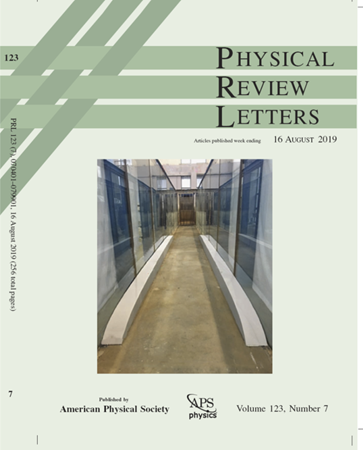作为分数量子和常规铁电性统一框架的广义诺伊曼原理
IF 9
1区 物理与天体物理
Q1 PHYSICS, MULTIDISCIPLINARY
引用次数: 0
摘要
单层In2±Se±3表现出意想不到的面内极化,尽管它具有𝐶3±𝑣对称性,这是传统上被认为是对称所禁止的特征。为了解释这种显著的行为,Ji等人提出了分数量子铁电(FQFE)的概念,其中极化发生在分数倍的量子中,并认为这种现象违反了传统的诺伊曼原理。在这篇文章中,我们引入了诺伊曼原理的一种广义形式,并证明了FQFE和传统铁电可以在这个统一的理论框架内一致地描述。我们提出了一种基于广义诺伊曼原理的系统识别FQFE材料的方法。这种方法应用起来很简单,为FQFE提供了清晰的概念理解和深刻的物理洞察力。利用这种方法,我们确定了32个晶体学点群中所有对称允许的FQFE情况。由于实际应用依赖于控制极化的能力,我们进一步证明了FQFE可以通过与常规极化的耦合有效地切换。以HfZnN2为例,我们揭示了这种耦合的潜在机制,并概述了识别具有类似开关行为的其他材料的策略。本文章由计算机程序翻译,如有差异,请以英文原文为准。
Generalized Neumann’s Principle as a Unified Framework for Fractional Quantum and Conventional Ferroelectricity
Monolayer In2Se3 exhibits unexpected in-plane polarization, despite having 𝐶3𝑣 symmetry, a feature that was traditionally considered forbidden by symmetry. To explain this remarkable behavior, Ji et al. proposed the concept of fractional quantum ferroelectricity (FQFE), in which polarization occurs in fractional multiples of a quantum, and argued that this phenomenon violates the conventional Neumann’s principle. In this Letter, we introduce a generalized form of Neumann’s principle and demonstrate that both FQFE and conventional ferroelectricity can be consistently described within this unified theoretical framework. We propose a method, based on the generalized Neumann’s principle, for the systematic identification of FQFE materials. This approach is straightforward to apply and offers a clear conceptual understanding and deep physical insight for FQFE. Using this method, we determine all symmetry-allowed FQFE cases across the 32 crystallographic point groups. Since practical applications rely on the ability to control polarization, we further show that FQFE can be effectively switched via coupling with conventional polarization. Using HfZnN2 as an illustrative example, we reveal the underlying mechanism of this coupling and outline a strategy to identify other materials with similar switching behavior.
求助全文
通过发布文献求助,成功后即可免费获取论文全文。
去求助
来源期刊

Physical review letters
物理-物理:综合
CiteScore
16.50
自引率
7.00%
发文量
2673
审稿时长
2.2 months
期刊介绍:
Physical review letters(PRL)covers the full range of applied, fundamental, and interdisciplinary physics research topics:
General physics, including statistical and quantum mechanics and quantum information
Gravitation, astrophysics, and cosmology
Elementary particles and fields
Nuclear physics
Atomic, molecular, and optical physics
Nonlinear dynamics, fluid dynamics, and classical optics
Plasma and beam physics
Condensed matter and materials physics
Polymers, soft matter, biological, climate and interdisciplinary physics, including networks
 求助内容:
求助内容: 应助结果提醒方式:
应助结果提醒方式:


